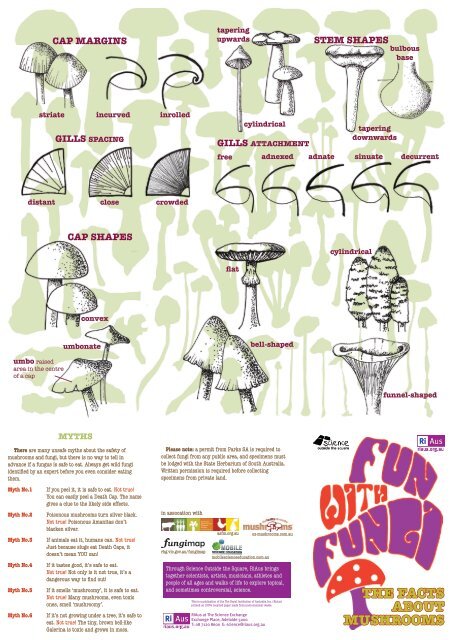View Fun with Fungi – The Facts about Mushrooms - RiAus
View Fun with Fungi – The Facts about Mushrooms - RiAus
View Fun with Fungi – The Facts about Mushrooms - RiAus
Create successful ePaper yourself
Turn your PDF publications into a flip-book with our unique Google optimized e-Paper software.
CAP MARGINS<br />
tapering<br />
upwards<br />
STEM SHAPES<br />
bulbous<br />
base<br />
striate incurved inrolled<br />
GILLS SPACING<br />
cylindrical<br />
GILLS ATTACHMENT<br />
tapering<br />
downwards<br />
free adnexed adnate sinuate decurrent<br />
distant close crowded<br />
CAP SHAPES<br />
cylindrical<br />
flat<br />
convex<br />
umbonate<br />
bell-shaped<br />
umbo raised<br />
area in the centre<br />
of a cap<br />
funnel-shaped<br />
MYTHS<br />
<strong>The</strong>re are many unsafe myths <strong>about</strong> the safety of<br />
mushrooms and fungi, but there is no way to tell in<br />
advance if a fungus is safe to eat. Always get wild fungi<br />
identified by an expert before you even consider eating<br />
them.<br />
Please note: a permit from Parks SA is required to<br />
collect fungi from any public area, and specimens must<br />
be lodged <strong>with</strong> the State Herbarium of South Australia.<br />
Written permission is required before collecting<br />
specimens from private land.<br />
Myth No.1<br />
Myth No.2<br />
Myth No.3<br />
Myth No.4<br />
Myth No.5<br />
Myth No.6<br />
If you peel it, it is safe to eat. Not true!<br />
You can easily peel a Death Cap. <strong>The</strong> name<br />
gives a clue to the likely side effects.<br />
Poisonous mushrooms turn silver black.<br />
Not true! Poisonous Amanitas don’t<br />
blacken silver.<br />
If animals eat it, humans can. Not true!<br />
Just because slugs eat Death Caps, it<br />
doesn’t mean YOU can!<br />
If it tastes good, it’s safe to eat.<br />
Not true! Not only is it not true, it’s a<br />
dangerous way to find out!<br />
If it smells ‘mushroomy’, it is safe to eat.<br />
Not true! Many mushrooms, even toxic<br />
ones, smell ‘mushroomy’.<br />
If it’s not growing under a tree, it’s safe to<br />
eat. Not true! <strong>The</strong> tiny, brown bell-like<br />
Galerina is toxic and grows in moss.<br />
in assocation <strong>with</strong><br />
rbg.vic.gov.au/fungimap<br />
asfm.org.au<br />
mobilescienceeducation.com.au<br />
Through Science Outside the Square, <strong>RiAus</strong> brings<br />
together scientists, artists, musicians, athletes and<br />
people of all ages and walks of life to explore topical,<br />
and sometimes controversial, science.<br />
This is a publication of the <strong>The</strong> Royal Institution of Australia Inc. (<strong>RiAus</strong>)<br />
printed on 100% recycled paper made from post-consumer waste.<br />
<strong>RiAus</strong> at <strong>The</strong> Science Exchange<br />
Exchange Place, Adelaide 5000<br />
T: 08 7120 8600 E: science@riaus.org.au<br />
oz-mushrooms.com.au<br />
THE FACTS<br />
ABOUT<br />
MUSHROOMS
WHAT ARE FUNGI?<br />
<strong>Mushrooms</strong> and fungi are living organisms which<br />
develop from spores, rather than seeds. A spore is a<br />
microscopic, single-celled structure.<br />
Unlike plants, mushrooms and fungi can’t make their<br />
own food through photosynthesis because they don’t<br />
contain chlorophyll. Instead, fungi produce an enzyme<br />
which breaks down complex molecules into smaller, simpler<br />
ones which can be absorbed by the fungi.<br />
<strong>Fun</strong>gi occupy most habitats, from rainforest to desert.<br />
<strong>The</strong>y grow in soil and on dung, on non-living organic<br />
material such as bread, and on and inside dead plants and<br />
animals as parasites. <strong>Fun</strong>gi are also found in both fresh<br />
and salt water environments.<br />
Some diseases, such as ringworm, thrush and athletes’<br />
foot are also forms of fungi.<br />
MUSHROOM or TOADSTOOL?<br />
<strong>The</strong>re is no difference between a mushroom and a<br />
toadstool. <strong>The</strong>y are the same thing! Popular culture tends<br />
to refer to edible species of fungi as ‘<strong>Mushrooms</strong>’ and nonedible<br />
species as ‘Toadstools’, but ‘<strong>Fun</strong>gus’ or ‘<strong>Fun</strong>gi’ is the<br />
more scientifically-accurate term to describe both!<br />
Other forms of fungi include:<br />
Puffballs, Earthballs, Earthstars and Stinkhorns<br />
Club, Coral and Jelly fungi<br />
Bracket and Shelf fungi<br />
Truffles, Disc and Cup fungi<br />
Moulds, Mildews, Rusts, Smuts and Yeast<br />
REPRODUCTION<br />
<strong>Fun</strong>gi reproduce by way of single-celled spores released<br />
into the atmosphere. Most fungi produce spores <strong>with</strong>in the<br />
gills <strong>–</strong> on the underside of the cap <strong>–</strong> and rely on the breeze<br />
to carry away the spores.<br />
Some species have more unusual methods of spore<br />
dispersal. Stinkhorns attract flies <strong>with</strong> their terrible smell,<br />
and sometimes have an appearance similar to that of<br />
rotting meat. <strong>The</strong> flies then carry away spores on their feet<br />
and disperse them wherever they land.<br />
Puffballs release spores through a hole in the top, which<br />
encourages the spores to puff out in a cloud. <strong>The</strong> Dung<br />
<strong>Fun</strong>gus can shoot its spores 1-2 metres into the air!<br />
Birds Nest <strong>Fun</strong>gi are small cup-like fungi containing<br />
multiple spore cases (peridioles) which resemble tiny eggs.<br />
<strong>The</strong>se species rely on raindrops to knock the peridioles out<br />
of the cup and into the atmosphere.<br />
Cannonball <strong>Fun</strong>gi shoot their single peridiole into the air<br />
when mature. Though the fungus itself is only a couple of<br />
millimetres in diameter, it can shoot its peridiole up to six<br />
metres away!<br />
TOXICITY<br />
In Europe and Asia there are centuries of trial and error<br />
behind local mushroom folklore <strong>about</strong> what is safe to eat<br />
and not. Science has only named and described 5% of the<br />
estimated 250,000 species of Australian fungi, and very<br />
little is known <strong>about</strong> Indigenous Australians’ use of fungi.<br />
<strong>The</strong>re are many ‘look-alikes’ in the mushroom kingdom.<br />
Unless you are an expert, don’t eat anything you can’t<br />
positively identify <strong>with</strong> 100% certainty. For instance, some<br />
specimens of Death Cap Mushroom (Amanita phalloides)<br />
look almost-identical to the edible Paddy Straw Mushroom<br />
(Volvariella volvacea).<br />
<strong>Fun</strong>gi can be unpredictable in their effects. Some people<br />
will have an allergic reaction to a particular species of<br />
fungus, while others will experience no ill effects. Other<br />
people have a severe allergic reaction to Oyster Mushroom<br />
spores, causing a condition known as ‘Mushroom Lung’.<br />
A person can have no reaction after one meal of<br />
mushrooms, but be violently ill the next time they try the<br />
same species.<br />
Some species, such as the Common Roll-rim (Paxillus<br />
involutus) have a toxic effect which only becomes apparent<br />
years after consumption.<br />
Some fungi have ill effects only when combined <strong>with</strong><br />
certain foods or drinks. For instance a species of Ink cap,<br />
(Coprinopsis atramentaria), has unpleasant side effects<br />
if consumed <strong>with</strong> alcohol because it produces a substance<br />
very similar to Antabuse, the proprietary drug used to<br />
treat chronic alcoholism.<br />
<strong>Fun</strong>gi are very good at absorbing toxins. This makes<br />
them great as natural cleaners of toxic waste, but means<br />
that mushrooms picked from the sides of roads, close to<br />
chemical sprays or vehicle exhaust, should never be eaten.<br />
Junior Field Naturalists SA Inc.<br />
Junior Field Naturalists SA Inc. is a nature club for<br />
primary school children held on the last Thursday of each<br />
month. Children are encouraged to bring along any<br />
interesting specimen (e.g. fossil, insect, etc.) for<br />
show-and-tell. Occasional Field Trips are held during the<br />
year.<br />
For further information contact:<br />
Rona Sakko, President, Junior Field Naturalists SA<br />
ronadel@dodo.com.au 0419 827 723<br />
MUSHROOM HEALTH<br />
<strong>Mushrooms</strong> are neither a fruit or vegetable. In fact, they<br />
are not even a plant food. <strong>Mushrooms</strong> reside in a different<br />
biological kingdom to either plants or animals. Because<br />
mushrooms are so different they have a different nutrient<br />
profile to vegetables as well. <strong>The</strong>re are over 3,000 types of<br />
edible mushrooms available in the world. <strong>The</strong> most common<br />
Western mushroom is the white capped ‘button’ mushroom.<br />
<strong>Mushrooms</strong> have a relatively small cost and a big impact<br />
on flavour. Try these dishes :<br />
• Mushroom omelette - add ham and any other<br />
vegetable you enjoy. <strong>Mushrooms</strong> add an amazing<br />
flavour to quiche or frittata.<br />
• Try adding enoki or oyster mushrooms <strong>with</strong> different<br />
texture and taste to soups and salads.<br />
• Add sliced mushroom to stir fries and spaghetti<br />
bolognaise, wraps and sandwiches.<br />
• Add some breadcrumbs and fresh herbs to large<br />
mushrooms, like Portobello mushrooms, and toast<br />
under the grill for a snack, entrée or to serve <strong>with</strong><br />
dinner.<br />
• Mushroom pizzas on pitta or muffin breads.<br />
• Grilled mushies on toast.<br />
• Add mushroom to BBQ skewers <strong>with</strong> meat and or other<br />
veggies.<br />
Mushies aren’t just for vegetarians! <strong>Mushrooms</strong> are a<br />
great source of vitamins and minerals and some protein<br />
as well as some of the other benefits below, making them a<br />
great food for all:<br />
1. <strong>Mushrooms</strong> contain some of the highest antioxidant<br />
quantities of any food in the world.<br />
2. <strong>Mushrooms</strong> are very filling but are low in kilojoules,<br />
making them a great ‘weight management’ food.<br />
3. A serve of mushrooms provides more than a quarter<br />
of your daily needs of the essential vitamins riboflavin,<br />
niacin, pantothenic acid and biotin. <strong>The</strong>se keep your<br />
metabolic system and cell production functioning<br />
efficiently.<br />
4. <strong>Mushrooms</strong> are a good source of essential minerals<br />
such as selenium and copper and folate - all those<br />
things found in vitamin supplements that nature can<br />
provide! Good intake of selenium is linked to a<br />
reduction in prostate cancer risk and folate protects<br />
against spina bifida in unborn babies.<br />
5. <strong>Mushrooms</strong> are a wonderful source of fibre, to keep<br />
your digestive system healthy.<br />
6. <strong>Mushrooms</strong> are a rich source of umami flavour, a rich<br />
savoury element, allowing the taster to use less salt in<br />
cooking or flavouring.<br />
NUTRIENT<br />
PROTEIN (g) 3.3<br />
CARBOHYDRATE (g) 0.3<br />
FAT (g) 0.3<br />
CHOLESTEROL (mg) 0<br />
FIBRE (g) 1.5<br />
ENERGY kJ (kcal) 103 (24)<br />
A 100g of raw mushrooms contains just<br />
103 kilojoules (24 Calories), virtually no fat,<br />
while giving you a healthy amount of fibre.<br />
<strong>The</strong> fibre in mushrooms differs to that found<br />
in vegetables in that it appears to help<br />
control blood cholesterol and may protect<br />
against some cancers.




